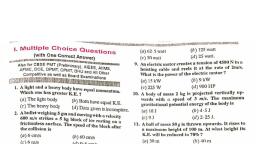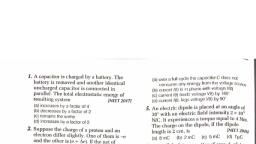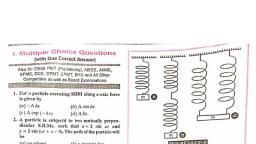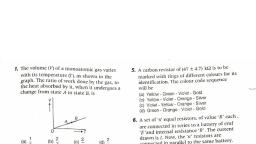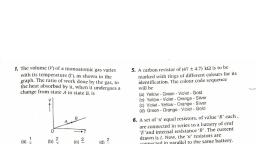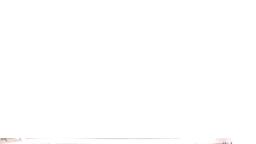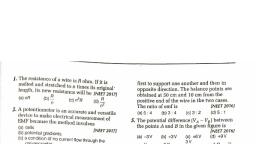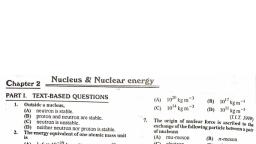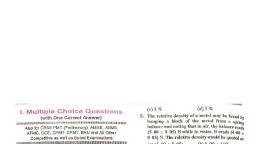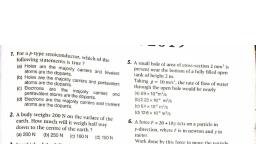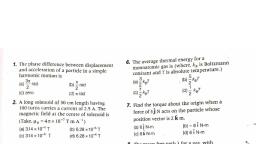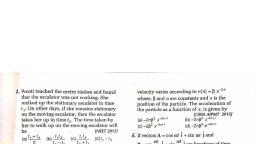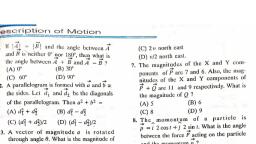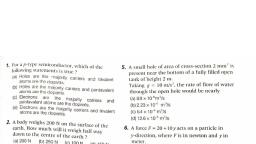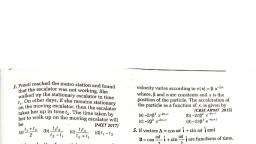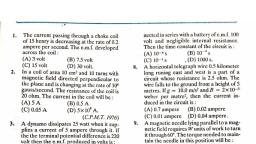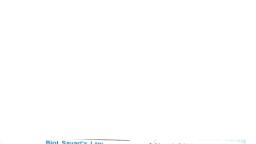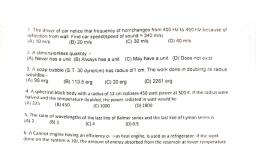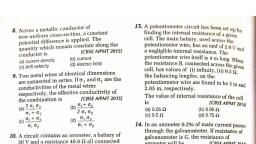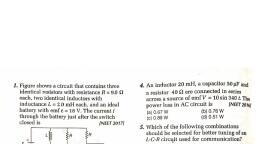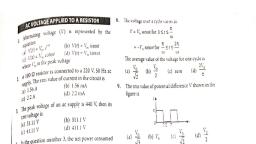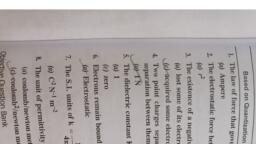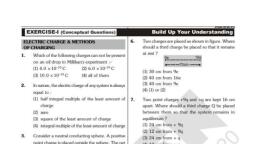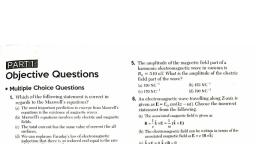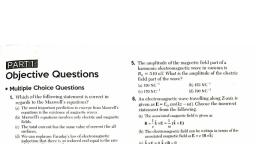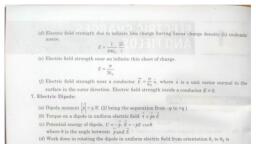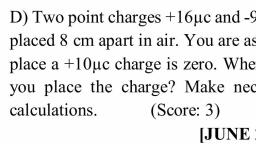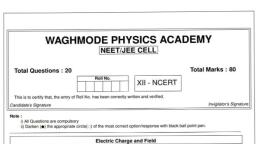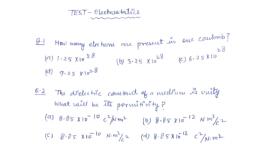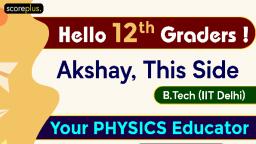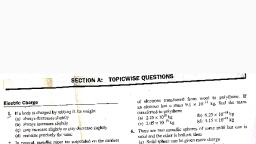Page 1 :
(B) there is a, , minimum sci, magnitude of charge Permissible, , Coulomb's law, , , , 1. Conservation of electric charge implies (C) charge, which is a fraction of coulomb j, that : not possible :, (A) charge exists on particles (D) none of the above., (B) charge cannot be destroyed 3. The magnitude of the two charges. js, (C) simultancous creation of equal and doubled and the distance of their separation ig, opposite charges is permissible = = The electrostatic force between, (D) the numbe icles i F, wie : don of charged particles in the (A) be halved, 2, Quantization of charge implies : Sy wtaed, (A) charge exists on particles (C) become four times, (D) remain unchanged.
Page 2 :
ELECTROSTATICS ‘ tien pieced in, nnn veen two charges, when phice, ae wp N If they “a in a medium of, relative permittivily 5, the force between them will, . (A)2N (B) SON, (C)0.5N (D) none of the above,, 5, 10° clectrons are added to a pith ball. The, charge on the pith ball will be ; re, (A) 1.6x107" C (B) 1.6x10°" C, (C) 1.6x10-* C (D) none of the above,, -610° electrons are taken out of a pith ball. The, charge on the pith will be :, (A) 1.6x 107" C (B) 1.6x10-"C, (C) 1.6x10-"C (D) none of the above., , 7. The minimum amount of charge observed so, far is:, (A) 1C (B) 4.8x10""C, (C) 1.6x10-"C (D) none of the above., 28. A positively charged glass rod is brought, near the disc of uncharged gold leaf electroscope., The leaves diverge, Which of the following, statement is correct ?, (A) No charge is present on the leaves, (B) Positive charge is induced on the leaves, (C) Negative charge is induced on the leaves, (D) Positive charge is induced on one leave and, negative charge is induced on the other leave,, 9. Mid way between the two equal and similar, charges, we place the third equal and similar, , charge. Which of the following statements is °, , correct ?, (A) The third charge experiences a net force, inclined to the line joining the charges, (B) The third charge is in stable equilibrium, (C) The third charge is in unstable equilibrium, (D) The third charge experiences a net force, perpendicular to the line joining the charges., , » 10. Two charges are placed a certain distance, apart. A metallic sheet is placed between them., What will happen to the force between the, charges?, , {A) Increases, , (B) Decreases, , (C) Remains unchanged i, , (D) May increase or decrease depending on, , the nature of metal. a, sare placed at a certain distance, , 11. Two charges I, apart, If dielectric slab is placed between them,, , wy, what happens to the force between the charges 9, , (A) Increases, , (B) Decreases, , (C) Remains unchanged, , (D) May increase or decrease depending on, the nature of the dielectric., , A2. Two charges of 24 C and 54 C are placed, 2.5 cm apart. The ratio of the Coulomb's force, experienced by them is :, , (A) 1:1 (B) 2:5, , (C) v2: V5 (D) 4: 25., , 13. Five balls numbered 1 to 5 are suspended, using separate threads, The pairs of balls (1, 2), (2,, 4) and (5, 1) show attraction while the pairs(2, 3), and (4, 5) show repulsion, The ball 1 is :, , (A) positively charged, , (B) negatively charged, , (C) neutral, , (D) may be positively or negatively charged., , 14. The dielectric constant of an insulator, cannot be :, , (A) 1.5 (B)3, , (C) 4.5 (D) ., , 15. The permitivity of vacuum is :, (A)1, , (B) more than 1, , (C) less than 1 but not zero, , (D) zero., , 16. Two charges q, and q, repell each other with, a force of 0.1 N, What will be the force exerted by, 4, 0ng,, When a third charge is placed near them?, , (A) Less than 0.1 N, , (B) More than 0.1 N, , (C)0.1N, , (D) Less than 0.1 N if g, and q, are similar and, morc than 0.1 N if g, and q, are dissimilar,, _ 17. The ratio of the force between two charges, in vacuum at a certain distance apart to that, between the same charges, the same distance apart, in a medium of permittivity ¢ is ;, , (A)er1 (B) l:e, , (C) e,:€ (D) none of the above., , 18. The ratio of electric force between (Wo, , electrons to the gravitational force berween them, is of the order of :, , (A) 10°, (C) 10°, , (B) 10”, (D)L.
Page 3 :
850, , 9.) The ratio of the electric force between two, Pretons to the gravitational force between them is, of the order of :, , (A) 10" (B) 10”, (C) 10° (D) 1., , The ratio of the electric force between two, pro ‘ons to that between two electrons under, similar conditions is of the order of :, , (A) 10° (B) 10”, , , (c)10” f° (Dy,, , R 21. A charge q is placed at the mid point of the, line joining two similar and equal charges each, equal to +24 C. The system will be in equilibrium, ifq =, , (A) —0.5n C (B) —1.04C, , (C) + 100 (D) + 0.54 C., , 22, What happens when charge is placed on a, , soap bubble ?, , (A) It collapses, , (B) Its radius increases, , (C) Its radius decreases, , (D) None of the above., , 23. Two balls carrying charges of +34 C and, , — 3 C attract each other witha force F. If charge, +3 0 C is added to both, the force between the, balls will be :, (A) 2F (B)F, (C) F/2 (D) Zero., 24. Two balls carrying charges + 84 C and, —5C attract cach other with a force F. If a, , charge — 3 Cis added to both, the force between, the bails will be :, (A) 2F (B) F, (C) Fi2 (D) Zero., 25. Threé small spheres each carrying a charge, q are placed on the circumference of a circle of, radius R, forming an equilateral triangle. If we, place another charge Q at the centre of the circle,, the force on Q will be :, , (A) Zero (B) qQ, 4nae,R°, , 2qQ 3402, (©) 4ue,R° ©) 4x eRe, , 26, Three charges 4q, Q andq are placedina, , ight linc of length / at points 0, //2, /, , oe 4 tively. What should be Q so as to make the, res :, , force 0" gro J, , ELECTROSTATICS, (A) —q/2 (B) —q, (C) —2q (D) —4q., , 27. Three charges cach equal to + 2 C are, placed at the corners of an equilateral triang!e, If, the force between any two charges be F, then the, net force on cither will be :, , (A)3F (B)2F, , (C) v2F (D) V3 F, 36. Fig. Q.28.1. shows a fixed charge Q and a, movable charge —q. The latter is free to move only, along the vertical direction. The charge —q is in, equilibrium, because its weight is balanced by the, , , , , , , , , , , , , , , , , , , , , , , , , , , , , , , , , , , , - +Q, , “-4, , Fig, Q-28.1, o-G, -+Q, (A) (B), , nce, , -+q oy, oe = | --@, (Cc) ‘D, , Fig. Q-28.2 ), , electrostatic attraction. In which cf the cases, shown in fig Q-28.2 the charge —q is in, , equilibrium? The separation between the charges, remains unchanged., , Electric field, , +29. The electric ficld due to a positive charge, adistance 2m is4NC™!. Its magnitude at distan®, of a4 m will be:, , (A) 0.5 NC (B) 1NC, ‘cCj2nc (D) none of the above:, , _ 30 In a region where intensity of electric el, is 5 NC, 40 lines of electric force are crossing
Page 4 :
BLDU ness, , uare metre. The number of lines crossing pet, square metre where intensity of electric field is 10, NC™ will be:, (A) 20 (B) 80, (C) 100 (D) 200., 31. A hollow copper sphere is positively, charged, the electric field at its centre will be :, (A) same as on the surface, , (B) less than that on the surface but not zero, (C) more than that at the surface, (D) zero., , 32. The electric field strength at a distance x, from a charge Q is E. What will be electric field, strength if the distance of the observation point is, increased by 2x ?, , (A) E/2 (B) E/3, , (C) E/4 (D) None of the above., , 33. As one penetrates uniformly charged, conducting sphere, what happens to the electric, field strength ?, , (A) Decreases inversely as the square of the, distance, , (B) Decreases inversely as the distance, , (C) Becomes zcro, , (D) Increases inversely as the square of, distance., , (34. How does the clectric field strength vary, when we enter a uniformly charged spherical, cloud ?, , (A) Decreases inversely as the square of the, distance from the surface., , (B) Decreases directly as the square of the, distance from the surface, , (C) Increases directly as the square of the, distance from the centre, , (D) Increases directly as the distance from the, centre. ;, , 45, The electric fieid at a distance R due to, charge q is E. If the same charge is placed on the, copper sphere of radius R, the electric field, strength at the surface of the conductor will be :, , (A) E/4 (B) E/2, , (C)E (D) 2E., , 36. In the question 35, above, the electric field, at distance 2 R from the centre of the spherical, , conductor will be :, , on, , (A) E/4 (B) E/2, , (C)E (D) 2E., , 37. The surface density on the co 1, is o. The electric field cot on Fed a, the sphere is : , (A)o (B) a/2, , (C) o/e, (D) 9/2¢,., , 38. A drop of oil density p and radius r carries, a charge q when placed in an electric field E, it, moves upwards with a velocity v., , If p, is the density of air, 7 be the viscosity of, the air, then which of the following forces is, directed upwards ?, , (A) 6x4rv, , ($2? @-p,)8, , 39. From where do the electric lines of force, are assumed to originate ?, , (A) Positive charge, , (B) Negative charge, , (C) Both from + VE and — VE charges, , (D) Neither from + VE charge nor from — V2, charge., , 40. The figure Q.40.1 shows electric ficld lines,, The electric field strength at P, is, and that at P,, is E,. If P, P, is,r, then which of the following, , (B)gE, (D) None of the above., , Fig. Q. 40,1, Statements is true ?, , (A)E, > E, (B) E, <E,, (C)E,=E/P (D) £,= rE,, 41° source charge q is located at 7 Tt
Page 5 :
ele, ©ctric field due to it at is given by :, , , , , , , , A _1l q, ( ae, (B) 5 r, mee, , (C) : aap tags (77, , 47 &, |r—T% |" °, , q, , (D I ais, TRF a9, 42. The unit of eléctric dipole moment is :, (A) Cm (B) Cm’, (C)C m (D) C’ m*, , 43. What is the angle between the electric, dipole moment and the electric field strength due, to it on the axial line ?, , (A) 0° (B) 90°, , (C) 180° (D) None of the above., fe What is the angle between the electric, dipole moment and the electric field strength due, to it on the equatorial line ?, , (A) 0° (B) 90°, 180° _ . (D) None of the above., 5. Electric field strength E due to a short —, dipole at a distance r from it are related as :, (A)E «rt (B) E « r?, (C)E «er (D) E «rt
